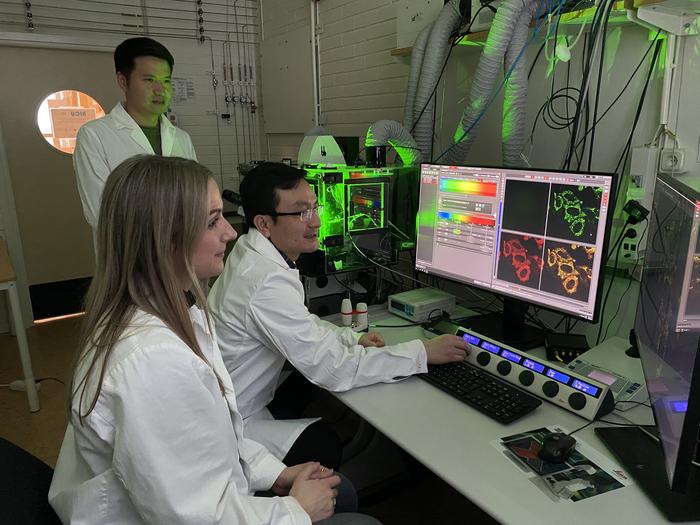
A groundbreaking research initiative at Umeå University has unveiled a revolutionary set of advanced light-controlled tools designed to manipulate proteins with astonishing precision in real-time within live cellular environments. This innovative approach promises to transform our understanding of complex biological processes by enabling scientists to observe and influence cellular dynamics at an unprecedented level. Researchers believe that the implications of this work extend beyond academic interest, potentially paving the way for significant breakthroughs in medicine and synthetic biology.
At the core of this research is the recognition that cellular functions are not static; they are intricate and dynamic, influenced by factors such as time, location, and environmental conditions. The cutting-edge chemical tool developed by the research team incorporates light-sensitive mechanisms that permit real-time control over cellular processes. “Cellular processes are complex and constantly change depending on when and where they occur within the cell,” says Professor Yaowen Wu, a prominent figure in this study. This newfound capability promises to revolutionize the study of cell biology, enabling researchers to gain insights into how cells maintain their vitality and functionality.
Controlling the intricate interplay of proteins and genes is fundamental to modern biological research. Traditional methodologies, such as the CRISPR-Cas9 genetic editing technique, often operate on extended timelines, introducing the risk of cellular adaptation and potentially obfuscating the results of experiments. The lack of spatial and temporal precision inherent in conventional techniques has posed substantial challenges for scientists wishing to investigate the dynamic nature of cellular functions. Addressing these challenges requires innovative approaches that can operate with precision over short intervals.
This research highlights the emergence of chemo-optogenetic systems as a formidable solution to the hurdles presented by traditional methods. These sophisticated systems blend the properties of chemical compounds, optical technologies, and engineered proteins to deliver precise control over protein activity at defined cellular locations, activated by specific wavelengths of light. The Wu lab is recognized as a leader in advancing the field of chemo-optogenetics, developing tools that enable unprecedented manipulations of light-sensitive proteins to study real-time cellular responses.
Historically, the Wu lab made remarkable strides with systems based on a category of molecular glue that facilitated the interaction between proteins. While these initial systems marked substantial progress, they still bore limitations in terms of usability and stability affected by photo-chemistry, which restricted their broader application in experimental biology. The researchers faced a pressing need to innovate further to overcome these constraints.
In a remarkable development, the Wu lab has recently published two pioneering studies that describe next-generation chemo-optogenetic tools harnessing photoswitchable molecular glues. These advancements significantly enhance the functionalities of prior systems, allowing for more significant versatility and stability. These new molecular glues can be toggled “on” or “off” like a switch through the application of appropriate light wavelengths. This feature enables multiple activation cycles, allowing researchers to alternately stimulate or inhibit protein functions with unprecedented spatial and temporal resolution.
Jun Zhang, a staff scientist at the Department of Chemistry at Umeå University, emphasizes the versatility of the new modular system. This innovative design paradigm enables adaptations to various experimental conditions, expanding the potential applications of these molecular tools in the investigation of protein dynamics and cellular behavior. As a result, scientists now have a reliable means of deciphering the complexities of cellular operations from the subcellular to cellular scale.
The practical implications of these advances are profound. The Wu lab has demonstrated through experimental testing that they can precisely regulate various cellular processes, including but not limited to, the functions and localization of proteins, positioning of organelles within the cell, and modulation of protein levels. This level of control equips biologists with a powerful toolkit to dissect and analyze the multifaceted dimensions of cellular life in real time.
The ability to manipulate proteins and other cellular components with such precision has immense ramifications for many scientific fields, including drug development and disease modeling. By better understanding the interactions of proteins in their natural environments, researchers can illuminate previously inaccessible pathways involved in diseases. More specifically, it could lead to the development of novel therapeutic strategies for a range of conditions, from cancer to neurodegenerative diseases, where protein interactions are known to be critical.
In conclusion, the advancements made by researchers at Umeå University mark an exciting frontier in cell biology research. By leveraging light-activated molecular tools, they have opened new avenues for studying the fundamental processes that govern cellular life. The contributions of this research group not only enhance our understanding of cellular mechanisms but also lay the groundwork for future innovations that could profoundly shape how we approach medical challenges. This research exemplifies the potential of interdisciplinary collaboration, merging chemistry, biology, and technology to forge tools that enhance our ability to explore and manipulate the microscopic world.
As scientists continue to uncover the mysteries of cellular dynamics, the promise of new discoveries hangs tantalizingly in the air. The integration of these advanced technologies heralds a new era in biology, inspiring innovations that could redefine our grasp of life at its most fundamental level.
Subject of Research: Advanced light-controlled tools for protein manipulation in living cells
Article Title: Modular Photoswitchable Molecular Glues for Chemo-optogenetic Control of Protein Function in Living Cells
News Publication Date: 7-Jan-2025
Web References: DOI Link
References: None provided
Image Credits: Shuang Li
Keywords: Biochemistry, Protein functions, Chemo-optogenetics, Cellular processes, Medical advances, Synthetic biology, Protein interactions, Live-cell imaging.
Tags: advanced cellular processesbreakthroughs in synthetic biologycellular dynamics regulationcomplex biological processesdynamic cellular functionsimplications for medicineinnovative approaches in cell biologylight-activated chemical toolslight-sensitive mechanisms in biologyobserving live cellular environmentsreal-time protein manipulationUmeå University research





